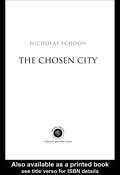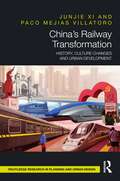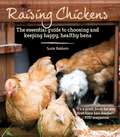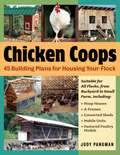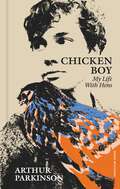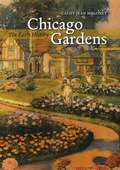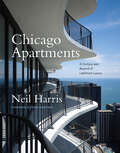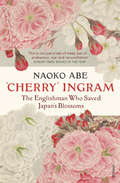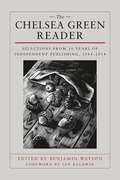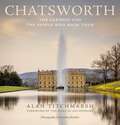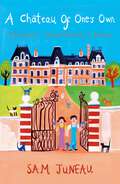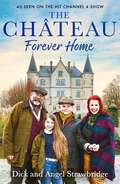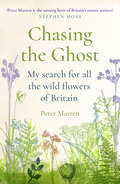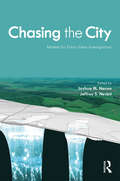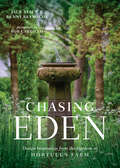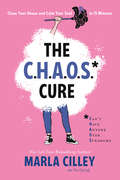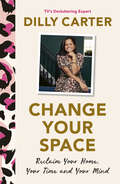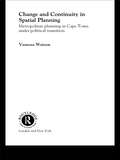- Table View
- List View
The Chosen City
by Nicholas SchoonThere is endless talk about the need for an urban renaissance; can it happen in the real world? In this broad, challenging and highly engaging book, Nicholas Schoon argues that the foremost priority for regeneration is to make neighbourhoods and cities places where people with choices choose to live.The author surveys the last two centuries of metropolitan growth and decay, analyzes the successes and failures of recent changes in urban policy and proposes a wide range of radical measures to make the renaissance a reality. Comprehensively researched, The Chosen City is a wake up call for everyone interested and involved in urban regeneration - degree students and academics, planning and housing professionals, architects, surveyors, developers and politicians. The text is illustrated with powerful black and white images from a leading national newspaper photographer.
Chiswick House Gardens: 300 years of creation and re-creation
by David JacquesThe grounds at Chiswick House are amongst the most iconic of all the historic gardens of Europe. In the 1720s they reflected Lord Burlington’s innovative ideas on Palladianism and antique gardens, whilst the area transformed by William Kent to give a rustic appearance in the early 1730s has been recognised as one of, or perhaps the, birthplace of the landscape garden. The grounds were periodically brought to the forefront of taste, reaching another high point as the venue for spectacular garden parties under the 6th Duke of Devonshire. As a garden of many periods it has given rise to passionate national debates since World War II on the principles of restoration, and as a public park it has been an important project assisted by the National Lottery Heritage Fund. Its renewed high state of keeping and its tranquil beauty belies its ‘deep’ history of intellectual debate, social tensions and practical difficulties. The book concentrates on the four main periods when Chiswick gardens were in the national spotlight, two when being in the forefront of taste and two concerning the restorations, the first being in the 1950s when the whole question of garden restoration was entirely new. The second restoration, on and off since 1988 intersects with the development of a philosophical stance and national policy on the restoration of parks and gardens. There is much of interest for art and architectural historians, garden historians, social historians and those local and international visitors who enjoy the finest public park in West London.
China’s Railway Transformation: History, Culture Changes and Urban Development
by Junjie Xi Paco Mejias VillatoroThis book investigates China’s railway transformation through history, along with culture changes and urban development. The book begins by looking at the background of China and the history and growth of railway development in China through five key phases, followed by assessing the cultural changes in the railway carriage and exploring how these are linked to social equality and national provisions. The core of this book aims to analyse the Chinese urban transformation through the development of the high-speed rail (HSR) infrastructure in China. Eleven important new HSR stations in mainland China, plus the new Hong Kong West Kowloon Station, have been selected to contextually explore how HSR infrastructures have affected the development of the Chinese urban context. The selected case studies are the stations of Beijing South, Wuhan, Shanghai Hongqiao, Guangzhou South, Xi’an North, Nanjing South, Chengdu East, Tianjin West, Zhengzhou East, Hangzhou East and Hong Kong West Kowloon. All of these were built between 2008 and 2018. In these case studies, the location and the intentions and success of promoting urban development are analysed and assessed. Following this, the book further investigates the peculiarities of the new HSR stations in China in comparison with stations in Europe. An assessment framework is established to evaluate the Chinese case studies comparatively with significant cases in Europe, attending to the urban structure of the area, the architectural quality, the functional diversity and the quality of the public space generated in the surrounding area.
China’s Railway Transformation: History, Culture Changes and Urban Development
by Junjie Xi Paco Mejias VillatoroThis book investigates China’s railway transformation through history, along with culture changes and urban development. The book begins by looking at the background of China and the history and growth of railway development in China through five key phases, followed by assessing the cultural changes in the railway carriage and exploring how these are linked to social equality and national provisions. The core of this book aims to analyse the Chinese urban transformation through the development of the high-speed rail (HSR) infrastructure in China. Eleven important new HSR stations in mainland China, plus the new Hong Kong West Kowloon Station, have been selected to contextually explore how HSR infrastructures have affected the development of the Chinese urban context. The selected case studies are the stations of Beijing South, Wuhan, Shanghai Hongqiao, Guangzhou South, Xi’an North, Nanjing South, Chengdu East, Tianjin West, Zhengzhou East, Hangzhou East and Hong Kong West Kowloon. All of these were built between 2008 and 2018. In these case studies, the location and the intentions and success of promoting urban development are analysed and assessed. Following this, the book further investigates the peculiarities of the new HSR stations in China in comparison with stations in Europe. An assessment framework is established to evaluate the Chinese case studies comparatively with significant cases in Europe, attending to the urban structure of the area, the architectural quality, the functional diversity and the quality of the public space generated in the surrounding area.
Chickens: The Essential Guide To Choosing And Keeping Happy, Healthy Hens (Gardening Ser.)
by Suzie BaldwinKeeping chickens is fun, relaxing, and low maintenance, plus you have the added benefit of your own known source of fresh eggs. In Chickens, poultry breeders Graham Page and Suzie Baldwin offer a practical guide to everything the beginner needs to know, from whether to buy chicks or hens, what varieties to chose, how to tell if you're buying a healthy chicken and how to ensure it stays that way, to how many chickens you should keep, and what kind of coop to buy. They also answer all the questions commonly posed by first-time owners, from whether chickens ever fly away and how quickly they will start laying, to how to prevent them being attacked by foxes and what to do when they become unwell.
Chicken Coops: 45 Building Ideas for Housing Your Flock
by Judy PangmanA collection of plans and concepts to inspire you to build a custom coop for your flock.
Chicken Boy: My Life With Hens
by Arthur ParkinsonA captivating, beautifully illustrated memoir of a life in nature, and a testament to the mutual rewards and delights of keeping chickens, by the Sunday Times bestselling author of The Flower Yard'I am a toddler the first time I meet a chicken, and we are equal in size and height. The hen has tiny eyelashes, a strawberry-jam face and a voice of purring clucks. I sense a happy spirit of inquisitiveness and smile in fascination. From that moment on, I will always love the company of chickens. I have found my tribe'Most of us want a dog, or a cat, or a pony when we are young - for Arthur Parkinson, it was always hens. Growing up in an ex-mining town in Nottinghamshire, the other kids in the playground called him 'Chicken Boy'. But the quiet fulfilment of keeping hens became his sanctuary, a tonic for mental and physical health, a connection with his family and the natural world. From the local allotments and his nan's back garden, to Chatsworth and an unlikely friendship with the late Duchess of Devonshire, a famous hen-keeper, Chicken Boy tells the story of the love and satisfaction to be found in caring for living things.Illustrated with Arthur's own characterful watercolours and photographs of his 'girls', and laden with practical hen-keeping tips, gardening advice and introductions to common, rare and pure breeds, Chicken Boy is a one-of-a-kind memoir of a life in nature.
Chicago Gardens: The Early History (Center for American Places - Center Books on American Places)
by Cathy Jean MaloneyOnce maligned as a swampy outpost, the fledgling city of Chicago brazenly adopted the motto Urbs in Horto or City in a Garden, in 1837. Chicago Gardens shows how this upstart town earned its sobriquet over the next century, from the first vegetable plots at Fort Dearborn to innovative garden designs at the 1933 World’s Fair. Cathy Jean Maloney has spent decades researching the city’s horticultural heritage, and here she reveals the unusual history of Chicago’s first gardens. Challenged by the region’s clay soil, harsh winters, and fierce winds, Chicago’s pioneering horticulturalists, Maloney demonstrates, found imaginative uses for hardy prairie plants. This same creative spirit thrived in the city’s local fruit and vegetable markets, encouraging the growth of what would become the nation’s produce hub. The vast plains that surrounded Chicago, meanwhile, inspired early landscape architects, such as Frederick Law Olmsted, Jens Jensen, and O.C. Simonds, to new heights of grandeur. Maloney does not forget the backyard gardeners: immigrants who cultivated treasured seeds and pioneers who planted native wildflowers. Maloney’s vibrant depictions of Chicagoans like “Bouquet Mary,” a flower peddler who built a greenhouse empire, add charming anecdotal evidence to her argument–that Chicago’s garden history rivals that of New York or London and ensures its status as a world-class capital of horticultural innovation. With exquisite archival photographs, prints, and postcards, as well as field guide descriptions of living legacy gardens for today’s visitors, Chicago Gardens will delight green-thumbs from all parts of the world.
Chicago Gardens: The Early History (Center for American Places - Center Books on American Places)
by Cathy Jean MaloneyOnce maligned as a swampy outpost, the fledgling city of Chicago brazenly adopted the motto Urbs in Horto or City in a Garden, in 1837. Chicago Gardens shows how this upstart town earned its sobriquet over the next century, from the first vegetable plots at Fort Dearborn to innovative garden designs at the 1933 World’s Fair. Cathy Jean Maloney has spent decades researching the city’s horticultural heritage, and here she reveals the unusual history of Chicago’s first gardens. Challenged by the region’s clay soil, harsh winters, and fierce winds, Chicago’s pioneering horticulturalists, Maloney demonstrates, found imaginative uses for hardy prairie plants. This same creative spirit thrived in the city’s local fruit and vegetable markets, encouraging the growth of what would become the nation’s produce hub. The vast plains that surrounded Chicago, meanwhile, inspired early landscape architects, such as Frederick Law Olmsted, Jens Jensen, and O.C. Simonds, to new heights of grandeur. Maloney does not forget the backyard gardeners: immigrants who cultivated treasured seeds and pioneers who planted native wildflowers. Maloney’s vibrant depictions of Chicagoans like “Bouquet Mary,” a flower peddler who built a greenhouse empire, add charming anecdotal evidence to her argument–that Chicago’s garden history rivals that of New York or London and ensures its status as a world-class capital of horticultural innovation. With exquisite archival photographs, prints, and postcards, as well as field guide descriptions of living legacy gardens for today’s visitors, Chicago Gardens will delight green-thumbs from all parts of the world.
Chicago Apartments: A Century and Beyond of Lakefront Luxury
by Neil Harris Teri J. EdelsteinThe Chicago lakefront is one of America’s urban wonders. The ribbon of high-rise luxury apartment buildings along the Lake Michigan shore has few, if any, rivals nationwide for sustained architectural significance. This historic confluence of site, money, style, and development lies at the heart of the updated edition of Neil Harris's Chicago Apartments: A Century and Beyond of Lakefront Luxury. The book features more than one hundred buildings, stretching from south to north and across more than a century, each with its own special combination of design choice, floor plans, and background story. Harris, with the assistance of Teri J. Edelstein, proves to be an affable and knowledgeable tour guide, guiding us through dozens of buildings, detailing a host of inimitable development histories, design choices, floor plans, and more along the way. Of particular note are recent structures on the Chicago River and south of the Loop that are proposing new definitions of comfort and extravagance. Featuring nearly 350 stunning images and a foreword by renowned Chicago author Sara Paretsky, this new edition of Chicago Apartments offers a wide-ranging look inside some of the Windy City’s most magnificent abodes.
Chicago Apartments: A Century and Beyond of Lakefront Luxury
by Neil Harris Teri J. EdelsteinThe Chicago lakefront is one of America’s urban wonders. The ribbon of high-rise luxury apartment buildings along the Lake Michigan shore has few, if any, rivals nationwide for sustained architectural significance. This historic confluence of site, money, style, and development lies at the heart of the updated edition of Neil Harris's Chicago Apartments: A Century and Beyond of Lakefront Luxury. The book features more than one hundred buildings, stretching from south to north and across more than a century, each with its own special combination of design choice, floor plans, and background story. Harris, with the assistance of Teri J. Edelstein, proves to be an affable and knowledgeable tour guide, guiding us through dozens of buildings, detailing a host of inimitable development histories, design choices, floor plans, and more along the way. Of particular note are recent structures on the Chicago River and south of the Loop that are proposing new definitions of comfort and extravagance. Featuring nearly 350 stunning images and a foreword by renowned Chicago author Sara Paretsky, this new edition of Chicago Apartments offers a wide-ranging look inside some of the Windy City’s most magnificent abodes.
Chicago Apartments: A Century and Beyond of Lakefront Luxury
by Neil Harris Teri J. EdelsteinThe Chicago lakefront is one of America’s urban wonders. The ribbon of high-rise luxury apartment buildings along the Lake Michigan shore has few, if any, rivals nationwide for sustained architectural significance. This historic confluence of site, money, style, and development lies at the heart of the updated edition of Neil Harris's Chicago Apartments: A Century and Beyond of Lakefront Luxury. The book features more than one hundred buildings, stretching from south to north and across more than a century, each with its own special combination of design choice, floor plans, and background story. Harris, with the assistance of Teri J. Edelstein, proves to be an affable and knowledgeable tour guide, guiding us through dozens of buildings, detailing a host of inimitable development histories, design choices, floor plans, and more along the way. Of particular note are recent structures on the Chicago River and south of the Loop that are proposing new definitions of comfort and extravagance. Featuring nearly 350 stunning images and a foreword by renowned Chicago author Sara Paretsky, this new edition of Chicago Apartments offers a wide-ranging look inside some of the Windy City’s most magnificent abodes.
Chicago Apartments: A Century and Beyond of Lakefront Luxury
by Neil Harris Teri J. EdelsteinThe Chicago lakefront is one of America’s urban wonders. The ribbon of high-rise luxury apartment buildings along the Lake Michigan shore has few, if any, rivals nationwide for sustained architectural significance. This historic confluence of site, money, style, and development lies at the heart of the updated edition of Neil Harris's Chicago Apartments: A Century and Beyond of Lakefront Luxury. The book features more than one hundred buildings, stretching from south to north and across more than a century, each with its own special combination of design choice, floor plans, and background story. Harris, with the assistance of Teri J. Edelstein, proves to be an affable and knowledgeable tour guide, guiding us through dozens of buildings, detailing a host of inimitable development histories, design choices, floor plans, and more along the way. Of particular note are recent structures on the Chicago River and south of the Loop that are proposing new definitions of comfort and extravagance. Featuring nearly 350 stunning images and a foreword by renowned Chicago author Sara Paretsky, this new edition of Chicago Apartments offers a wide-ranging look inside some of the Windy City’s most magnificent abodes.
'Cherry' Ingram: The Englishman Who Saved Japan’s Blossoms
by Naoko AbeThe irresistible story of Japanese cherry blossoms, threatened by political ideology and saved by an unknown EnglishmanCollingwood Ingram, known as ‘Cherry’ for his defining obsession, was born in 1880 and lived until he was a hundred, witnessing a fraught century of conflict and change. After visiting Japan in 1902 and 1907 and discovering two magnificent cherry trees in the garden of his family home in Kent in 1919, Ingram fell in love with cherry blossoms, or sakura, and dedicated much of his life to their cultivation and preservation.On a 1926 trip to Japan to search for new specimens, Ingram was shocked to see the loss of local cherry diversity, driven by modernisation, neglect and a dangerous and creeping ideology. A cloned cherry, the Somei-yoshino, was taking over the landscape and becoming the symbol of Japan's expansionist ambitions.The most striking absence from the Japanese cherry scene, for Ingram, was that of Taihaku, a brilliant ‘great white’ cherry tree. A proud example of this tree grew in his English garden and he swore to return it to its native home. Multiple attempts to send Taihaku scions back to Japan ended in failure, but Ingram persisted.Over decades, Ingram became one of the world’s leading cherry experts and shared the joy of sakura both nationally and internationally. Every spring we enjoy his legacy. ‘Cherry’ Ingram is a portrait of this little-known Englishman, a story of Britain and Japan in the twentieth century and an exploration of the delicate blossoms whose beauty is admired around the world.
The Chelsea Green Reader: Selections from 30 Years of Independent Publishing, 1984-2014
by Ben Watson Ian BaldwinChelsea Green, the Vermont-based independent publisher, has always had a nose for authors and subjects that are way ahead of the cultural curve, as is evident in this new anthology celebrating the company’s first thirty years in publishing. The more than one hundred books represented in this collection reflect the many distinct areas in which we have published–from literature and memoirs to progressive politics, to highly practical books on green building, organic gardening and farming, food and health, and related subjects–all of which reflect our underlying philosophy: "The politics and practice of sustainable living." The Chelsea Green Reader offers a glimpse into our wide-ranging list of books and authors and to the important ideas that they express. Interesting and worth reading in their own right, the individual passages when taken as a whole trace the evolution of a highly successful small publisher–something that is almost an oxymoron in these days of corporate buyouts and multinational book groups. From the beginning, Chelsea Green's books were nationally recognized, garnering positive reviews, accolades, and awards. We’ve published four New York Times bestsellers, and our books have set the standard for in-depth, how-to books that remain relevant years–often decades–beyond their original publication date. "Chelsea Green was born from a single seed: the beauty of craft. Craft in writing and editing, in a story well told, or a thesis superbly expressed," writes cofounder and publisher emeritus Ian Baldwin in the book's foreword. Today, craft continues to inform all aspects of our work–design, illustration, production, sales, promotion, and beyond. It has even informed our business model: In 2012, Chelsea Green became an employee-owned company. With the rise of the Internet, new media platforms, and a constantly shifting bookselling landscape, the future of publishing is anything but predictable. But if Chelsea Green's books prove anything, it is that, despite these challenges, there remains a hunger for new and important ideas and authors, and for the permanence and craftsmanship of the printed word. Today our ongoing mission is stronger than ever, as we launch into our next thirty years of publishing excellence.
Chatsworth: The gardens and the people who made them
by Alan TitchmarshDiscover Jane Austen's real-life inspiration for Darcy's Pemberley.Follow Alan into Chatsworth's irresistible world of visionaries, pioneers, heroes, villains and English eccentrics, and celebrate the men and women who have shaped the history of the estate over five centuries. With his passionate knowledge of both the house and gardens, as well as his long-established relationship with the Cavendish family, Alan is the perfect guide with whom to explore the Palace of the Peaks.Featuring stunning, specially commissioned photography of the gardens and parkland, alongside long-forgotten images and memorabilia newly unearthed in the estate archives, this vivid companion, crowded with character and colour, is a book to treasure and revisit over and over again.
A Chateau of One's Own: Restoration Misadventures in France
by Sam JuneauSam and Bud intended to move to France and create a simple life with their children. However they bought a 17th century chateau with over thirty rooms. With modest savings, they restored the building and started a bed and breakfast against resistance from the locals. This is a glimpse into what it takes to leave everything behind to pursue a dream.
The Chateau - Forever Home: The final chapter of our greatest adventure
by Dick Strawbridge Angel StrawbridgeReturn to life at Château-de-la-Motte Husson in the concluding memoir from Sunday Times bestselling authors, Dick and Angel Strawbridge.Picking up from where Living the Château Dream ended, Dick and Angel recount the newest and biggest challenges they faced on the journey to transforming their once derelict and abandoned château in France's Pays de la Loire into a thriving family home and sustainable business.When the Covid-19 pandemic engulfs the world, the château faces a new challenge and the Strawbridges must find ways to adapt in order to keep their dream life in France alive. From the cancellation of the wedding season to finding new ways to complete renovations, living in an isolated bubble whilst continuing to film their TV series through to life after the pandemic, this is Dick and Angel at their most honest and heartfelt, revealing many details never seen on TV.As entertaining, warm and irresistible as ever, this is the final chapter in Dick and Angel's remarkable journey to find their family's forever home.
Chasing the Ghost: My Search for all the Wild Flowers of Britain
by Peter MarrenJoin renowned naturalist Peter Marren on an exciting quest to see every species of wild plant native to Britain. The mysterious Ghost Orchid blooms in near darkness among rotting leaves on the forest floor. It blends into the background to the point of invisibility, yet glows, pale and ghostly. The ultimate grail of flower hunters, it has been spotted only once in the past twenty-five years. Its few flowers have a deathly pallor and are said to smell of over-ripe bananas. Peter Marren has been a devoted flower finder all his life. While the Ghost Orchid offers the toughest challenge of any wild plant, there were fifty more British species Peter had yet to see, having ticked off the first 1,400 rummaging in hedges, slipping down gullies and peering in peat bogs. But he set himself the goal of finding the remaining fifty in a single summer. As it turned out, the wettest summer in years. This expert and emotional journey takes Peter the length and the breadth of the British Isles, from the dripping ancient woods of the New Forest to the storm-lashed cliffs of Sutherland. He paddles in lakes, clambers up cliffs in mist and rain, and walks several hundred miles, but does he manage to find them all? Partly about plants, partly autobiography, Chasing the Ghost is also a reminder that to engage with wild flowers, all we need to do is look around us and enjoy what we see. Praise for Rainbow Dust: ‘Beautifully written and thoroughly researched… a truly marvellous book’ Telegraph ‘A scholarly and captivating excursion into the history of natural history’ Independent
Chasing the City: Models for Extra-Urban Investigations
by Joshua M Nason Jeffrey S NesbitHistorically, many architects, planners, and urban designers solicit idealistic depictions of a controllable urban environment made from highly regulated geometrical organizations and systematically defined processes. Rather than working as urban "designers" who set out to control and implant external processes, we shift our approach to that of urban "detectives," who set out to chase the city. Charged with approaching the city more responsively, we investigate what we do not know, allowing the city to direct our work. As urban detectives, we have the ability to interrogate and respond to the elaborate patterns emerging from self-generated, internalized urban interactions. Chasing the City asks what are the current design trends shaping how we, first, understand the cities of today to, then, produce informed decisions on the continuously undefined evolving city of tomorrow. Intentionally, the work here does not adhere to rudimentary notions of supposed singularities or rely upon past generations of idealistic utopian models. Rather, Chasing the City delineates current models of urban investigation that seek to respond to the nature of cities and develop heretofore-urban strategies as concurrently negotiated future urbanism. This edited volume provides a collection of innovative design research projects based on shared notions of Chasing the City through three bodies of strategic frameworks: (1) Mapping, (2) Resource, and (3) Typology. This structure ultimately allows readers, as fellow urban detectives, access to exploratory tools and methods of detection that accumulate from our environs, both practical and projective in our chase of the city.
Chasing the City: Models for Extra-Urban Investigations
by Joshua M Nason Jeffrey S NesbitHistorically, many architects, planners, and urban designers solicit idealistic depictions of a controllable urban environment made from highly regulated geometrical organizations and systematically defined processes. Rather than working as urban "designers" who set out to control and implant external processes, we shift our approach to that of urban "detectives," who set out to chase the city. Charged with approaching the city more responsively, we investigate what we do not know, allowing the city to direct our work. As urban detectives, we have the ability to interrogate and respond to the elaborate patterns emerging from self-generated, internalized urban interactions. Chasing the City asks what are the current design trends shaping how we, first, understand the cities of today to, then, produce informed decisions on the continuously undefined evolving city of tomorrow. Intentionally, the work here does not adhere to rudimentary notions of supposed singularities or rely upon past generations of idealistic utopian models. Rather, Chasing the City delineates current models of urban investigation that seek to respond to the nature of cities and develop heretofore-urban strategies as concurrently negotiated future urbanism. This edited volume provides a collection of innovative design research projects based on shared notions of Chasing the City through three bodies of strategic frameworks: (1) Mapping, (2) Resource, and (3) Typology. This structure ultimately allows readers, as fellow urban detectives, access to exploratory tools and methods of detection that accumulate from our environs, both practical and projective in our chase of the city.
Chasing Eden: Design Inspiration from the Gardens at Hortulus Farm
by Jack Staub Renny ReynoldsUsing their garden, Hortulus Farm in Bucks County, PA, as an example, celebrated gardeners and tastemakers Jack Staub and Renny Reynolds explain the principles of garden design, and give gardeners the courage to know when to break them.
The CHAOS Cure: Clean Your House and Calm Your Soul in 15 Minutes
by Marla CilleyWith the help of New York Times bestselling author and housekeeping guru Marla Cilley, you'll cure your household CHAOS (Can't Have Anyone Over Syndrome) by changing your messy home into a soothing sanctuaryAre you suffering from CHAOS, otherwise known as Can't Have Anyone Over Syndrome? If your house is a jumble of dirty dishes, piles of paper, and never-ending laundry, you are probably afflicted. But don't give up hope, because now there's an antidote: The CHAOS Cure. In her eagerly anticipated new book, Marla Cilley--aka "The FlyLady" to the hundreds of thousands who visit her website for daily domestic inspiration--reaches into our homes to help make housecleaning more meaningful and life less messy. With a little bit of armchair therapy and plenty of practical, tactical tips--such as "On the Fly!" quick fixes and genius uses for sticky notes--she'll help us get our houses in shipshape order before we can break a sweat. Along the way, the FlyLady teaches us to embrace household maintenance as an act of self-care, and to enjoy the soothing satisfaction of an orderly habitat.Before you know it, you'll be on the fast-track to living CHAOS-free, surrounded by sparkling serenity.
Change Your Space: Reclaim Your Home, Your Time and Your Mind
by Dilly CarterAs seen on TVHave you fallen out of love with your home?Has it stayed the same while your life has moved on?Are you ready to live with less stuff and more calm?If your answer's yes to any of these questions, this book is for you.Join Dilly Carter, professional organiser and TV's decluttering supremo, as she shows you how to clear, re-organise and fall back in love with your space, whatever your situation.Changing your space is a process that requires a shift in mindset. However, the good news is you'll start noticing results with even the smallest changes; and with dedication and commitment you can reclaim your home, your time and your mind.Learn how to conduct a 'space audit', follow Dilly's 6 golden rules of decluttering and use her quick-and-easy 15-minute Dolly Dashes to be well on the road to a calmer, happier home. With a seasonal planner and a 7-day challenge alongside Dilly's Top Tidy Tips, you will learn how to adapt, share, change and accept your space so that you can fully enjoy it once again.DILLY CARTER is the founder of Declutter Dollies (@declutterdollies) an organising and home-styling service. She regularly appears on TV providing advice on how to clear your space.
Change and Continuity in Spatial Planning: Metropolitan Planning in Cape Town Under Political Transition (Cities And Regions Ser.)
by Vanessa WatsonChange and Continuity in Spatial Planning addresses a question of enduring interest to planners: can planning really bring about significant and positive change? In South Africa the process of political transition appeared to create the preconditions for planners to demonstrate how their traditional humanitarian and environmental concerns could find concrete expression in the reshaping of the built environment.Integral to this story is how planning practices have been shaped by the past, in a rapidly changing context characterised by a globalising economy, new systems of governance, a changing political ideology, and a culture of intensifying poverty and diversity. More broadly, the book addresses the issue of how planners use power, in situations which themselves represent networks of power relations, where both planners and those they engage with operate through frames of reference fundamentally shaped by place and history.
